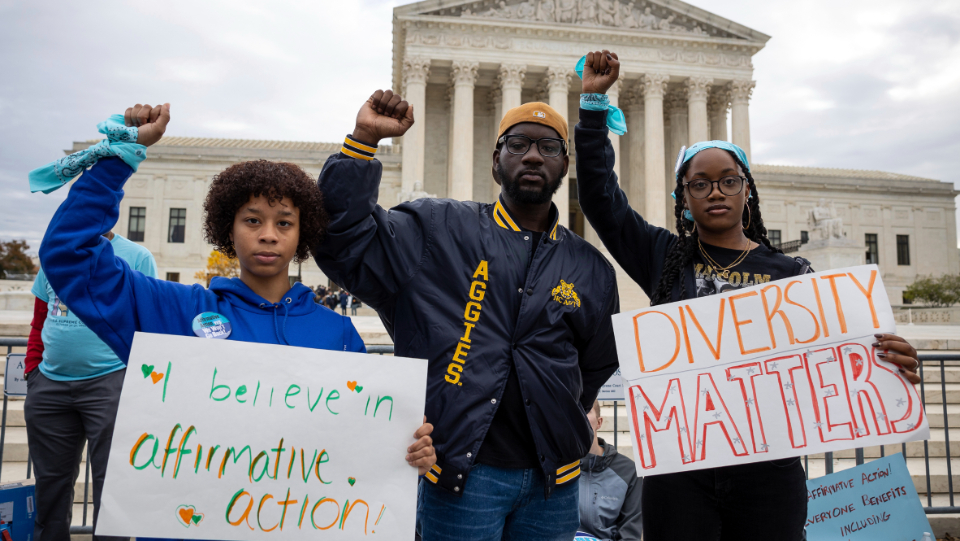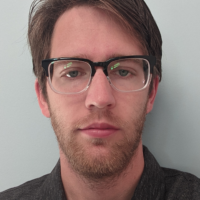
“Nations reel and stagger on their way; they make hideous mistakes; they commit frightful wrongs; they do great and beautiful things. And shall we not best guide humanity by telling the truth about all this, so far as the truth is ascertainable?” – W.E.B. Du Bois, Black Reconstruction in America
On Halloween, the Supreme Court heard oral arguments on the issue of affirmative action. Based on the questions asked during the hearing, it seems likely the right-wing court will limit, if not eliminate, affirmative action in higher education. What are the historic roots of affirmative action, why is it under attack by the court, and what can we do?
Affirmative action comes from the 14th Amendment’s Equal Protection Clause and is the legal idea that the oppressed should be treated fairly, protected from the powerful, and permitted to build democracy.
The issue before the Supreme Court is whether colleges can use race as a factor in admissions. A large faction of the ruling class is opposed to fairness, and uses division around race to pull voters to its side. Using lawyers and confusing language, they advocate for a sham version of equality. They push the narrow and ineffective idea that all races should be treated strictly “equal,” and that schools should ignore the history of racism because it’s not “fair” to less-exploited groups.
The 14th Amendment came out of the ruins of the Civil War (1861-65). In rebelling states like Louisiana and Georgia, the enslaved liberated themselves. They went on strike, threw down their tools, and walked off the plantation. The self-liberated and their allies in the Union Army seized plantations, giving the impoverished the resources to begin building a new society.
After the Civil War, self-liberated peoples built democracy in the South by taking power in their homes, communities, and schools. Because they had land and were their own boss, they used their labor to enrich their community. They paid for things like the Freedmen’s Bureau, as opposed to enriching planters and mill owners. This was the period of Radical Reconstruction.
As the people built democracy, the fear and greed of the oppressors grew in response. In the agricultural-based economy of the South, the oppressors were the remnants of the rapidly declining planter class and the emergent capitalists (“carpetbaggers”) who legally controlled the land and tools of farming, as well as the means to enforce adhesive employment contracts that imposed harsh conditions on free labor.
The 14th Amendment was adopted by the Union in 1868 during this violent period. It was enacted to protect the growth of democracy among the oppressed, who were starting to send Black representatives to state capitols. At that time, planters and ex-Confederates were rushing to establish governments opposed to the democratic work of the self-liberated and dedicated to restoring white supremacist planter rule. When the Union Army was prematurely removed from the South, the promise of 40 acres and a mule was revoked, and the Klan and bosses were left free to terrorize and exploit.
The enemies of democracy used the social influence of defeated and bitter military and political leaders to radicalize masses of poor, ignorant whites with anti-Black propaganda. They blamed liberated slaves for the lowered living standards that resulted from the South losing the Civil War. Mobs burned down the institutions of democracy, such as the schools and churches at the heart of the Black community, and terrorized and killed the Black electorate. As these groups of workers fought among each other, the oppressors were able to use the chaos and instability to drive down wages, create conditions of scarcity, and militarize society.
In this context of terrorism, the powerful used courts and lawyers to turn the 14th Amendment on its head, to have the laws on the books match the reality on the ground. The loudest example was Plessy v. Ferguson (1896). In that case, the Supreme Court said the fictional equality of “separate but equal” was legal. This gave states the green light to impose legal segregation and drive a wedge between white and Black. This oppressed newly liberated Black Americans in exactly the ways the 14th Amendment was meant to prohibit.
Through organizing and direct advocacy, people have repeatedly pushed back against sham equality. The Supreme Court reacted to this on-the-ground reality with decisions like Brown v. Board of Ed (1954) and Loving v. Virginia (1967), which outlawed school segregation and legalized interracial marriage.
The sham equality of “separate but equal” never matched the historic purpose of the 14th Amendment, and people have been resisting it ever since it became a legal reality over 125 years ago. In Grutter v. Bollinger (2003), the Supreme Court again reacted to on-the-ground reality and upheld the now-threatened policy allowing schools to consider the history of race-based oppression in college admissions.
Just as the self-liberated took action to acquire a material basis for community-building after the Civil War, so to can the self-liberated “seize” the classrooms and libraries to acquire a material basis for community building today. And, just as the opponents of freedom used courts and lawyers to weaken the 14th Amendment in the past, so to do today’s opponents use courts and lawyers to chip away at its goal of real equality.
The opponents of the 14th Amendment’s historic purpose are manipulating our instinct for fairness. In a recent analysis of public opinion by FiveThirtyEight, an individual’s position on affirmative action was found to change based solely on the wording of the question asked—even when the question essentially asked the same thing.
This flip-flopping of opinion shows the right wing’s effort to sew mass confusion is having an effect. It also shows a major section of the U.S. public is vulnerable to the same dangerous manipulation that allowed the enemies of democracy to divide workers along race lines in the past. Understanding our history will provide a foundation for creating the consciousness and unity needed in today’s struggle for democracy.

MOST POPULAR TODAY

Zionist organizations leading campaign to stop ceasefire resolutions in D.C. area


High Court essentially bans demonstrations, freedom of assembly in Deep South

Afghanistan’s socialist years: The promising future killed off by U.S. imperialism

Communist Karol Cariola elected president of Chile’s legislature






Comments